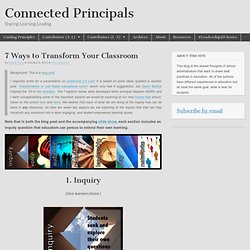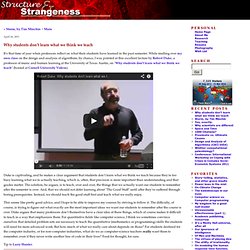

Projet. MOOC. Construisons l'école numérique - Partage. The impact of video in education (infographic) 7 Ways to Transform Your Classroom. Background: This is a blog post I originally wrote for a presentation on Classroom 2.0 Live!

It is based on some ideas sparked in another post, Transformative or just flashy educational tools? , which only had 6 suggestions, but David Warlick inspired the 7th in his comment. The 7 aspects below, were developed when principal Stephen Whiffin and I were conceptualizing some of the important aspects we would be exploring at our new Inquiry Hub school, (more on the school here and here). We believe that much of what we are doing at the Inquiry Hub can be done in any classroom.
So here are seven key aspects we are exploring at the Inquiry Hub that can help transform any classroom into a more engaging, and student-empowered learning space. Note that in both the blog post and the accompanying slide show, each section includes an inquiry question that educators can persue to extend their own learning. (Give learners choice.) Inquiry based learning is a key tenet of the Inquiry Hub.
Et si l’on arrêtait d’utiliser des manuels scolaires. Au vu des ressources disponibles en ligne et des pratiques individuelles des enseignants on peut se demander s’il faut encore maintenir des manuels scolaires ?

Si l’on fait l’hypothèse que les ressources libres disponibles se multiplient, que la maîtrise des enseignants dans l’élaboration de supports pour leur enseignement augmente et que les élèves ont pris l’habitude eux aussi d’aller chercher leurs ressources, on peut s’interroger sur l’intérêt d’utiliser des manuels scolaires. Cette remarque, qui pourra sembler une provocation envers une « industrie » dont le chiffre d’affaire passe largement par ce marché et qui donc se verrait progressivement diminuer, voire disparaître, n’a pour objectif que de poser une question importante que l’on esquive dans de nombreux débats, tant elle recouvre d’autres éléments qui seraient affectés indirectement par de tels développements. Outre la dimension économique, c’est l’usage qui doit être questionné. Mais cela n’est pas pour demain matin…
Organismes et rapports. Pédagogie et technologie. Apprentissages et émotions. Évaluations et Devoirs. Classe inversée. Cerveau. Structure+Strangeness: Why students don't learn what we think we teach. « Storm, by Tim Minchin | Main April 26, 2011 Why students don't learn what we think we teach It's that time of year when professors reflect on what their students have learned in the past semester.

While mulling over my own class on the design and analysis of algorithms, by chance, I was pointed at this excellent lecture by Robert Duke, a professor of music and human learning at the University of Texas Austin, on "Why students don't learn what we think we teach" (hosted at Cornell University Videos). Duke is captivating, and he makes a clear argument that students don't learn what we think we teach because they're too busy learning what we're actually teaching, which is, often, that precision is more important than understanding and that grades matter. This seems like pretty good advice, and I hope to be able to improve my courses by striving to follow it.
Tip to Larry Hunter.
Motivation et estime de soi. CARTOTHEQUE Idées ASH - Idées ASH.